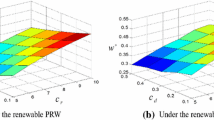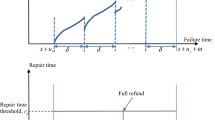Abstract
Renewing warranty can provide customers with better service, and thus help manufacturers to gain market opportunities. In engineering practice, the cost for replacement is usually higher than the cost for maintenance, hence manufacturers often face huge challenge to reduce the warranty service cost. With consideration of the warranty deadline, we propose a two-stage optimization model for renewing warranty. In the first stage, a renewing warranty with deadline (RWD) policy is implemented, where the deadline represents the cumulative uptime threshold. When the cumulative uptime exceeds the deadline, the product will be minimally repaired and kept to the residual warranty period. When RWD is expired, the replacement warranty with limited repairs (RWLR) policy is applied. Under the free replacement and pro-rata warranty policy, the corresponding two-stage cost optimization model is established from the manufacturer’s perspective, the aim is to minimize the cost rate and obtain the optimal warranty period. A numerical example is provided to illustrate the validity of the proposed model, and the sensitivity analysis is also carried out.
摘要
更新质保可以为顾客提供更优质的服务,帮助企业赢得市场机会。但是,在工程实际中替换成 本通常高于维修成本,制造商将面临如何降低质保服务成本的严峻挑战。本文提出一种考虑质保截止 期的两阶段更新质保优化模型。在第一阶段,制造商提供带有截止期的更新质保(RWD),其中截止期 表示累计运行时间阈值,当产品累积运行时间超出截止期时,在余下的质保期内制造商将会对产品采 取最小维修。当第一段质保期满结束,制造商将提供具有有限维修次数限制的替换质保(RWLR)。文 中以成本率最小为优化目标,从制造商的视角分别建立基于免费替换、按比例分摊质保的两阶段成本 优化模型,通过求解模型得到最优质保期。文中通过案例验证所提出模型的有效性,并完成参数灵敏 度分析。
Similar content being viewed by others
References
ZHAO Xiu-jie, XIE Min. Using accelerated life tests data to predict warranty cost under imperfect repair [J]. Computers & Industrial Engineering, 2017, 107: 223–234. DOI: 10.1016/j.cie.2017.03.021.
MO Si-min, ZENG Jian-chao, XU Wei-bin. A new warranty policy based on a buyer’s preventive maintenance investment [J]. Computers & Industrial Engineering, 2017, 111: 433–444. DOI: 10.1016/ j.cie.2017.07.036.
SU Chun, WANG Xiao-lin. Modeling flexible two-dimensional warranty contracts for used products considering reliability improvement actions [J]. Proceedings of the Institution of Mechanical Engineers, Part O: Journal of Risk and Reliability, 2016, 230(2): 237–247. DOI: 10.1177/1748006X15627395.
YANG Duo, HE Zhen, HE Shu-guang. Warranty claims forecasting based on a general imperfect repair model considering usage rate [J]. Reliability Engineering & System Safety, 2016, 145: 147–154. DOI: 10.1016/j.ress.2015.09. 012.
CHEN C K, LO C C, WENG T C. Optimal production run length and warranty period for an imperfect production system under selling price dependent on warranty period [J]. European Journal of Operational Research, 2017, 259(2): 401–412. DOI: 10.1016/j.ejor.2016.10.038.
PARK M, JUNG K M, PARK D H. Optimization of periodic preventive maintenance policy following the expiration of two-dimensional warranty [J]. Reliability Engineering & System Safety, 2018, 170: 1–9. DOI: 10.1016/j.ress.2017.10. 009.
VAHDANI H, MAHLOOJI H, JAHROMI A E. Warranty servicing for discretely degrading items with non-zero repair time under renewing warranty [J]. Computers & Industrial Engineering, 2013, 65(1): 176–185. DOI: 10.1016/j.cie.2011. 08.012.
MONDAL S, PAL S, MANNA D K. Cost estimation under renewing warranty policy?An application [J]. Quality Engineering, 2003, 16(1): 93–98. DOI: 10.1081/QEN-120020775.
LI Xin-yue, JIA Yun-xian, WANG Peng, XIE Jian, GAO Qin-he, SI Xiao-sheng. Renewable warranty policy for multiple-failure-mode product considering different maintenance options [J]. Eksploatacja i Niezawodnosc-Maintenance and Reliability, 2015, 17(4): 551–560. DOI: 10.17531/ein.2015.4.10.
SHAFIEE M, CHUKOVA S. Maintenance models in warranty: A literature review [J]. European Journal of Operational Research, 2013, 229(3): 561–572. DOI: 10.1016/j.ejor.2013.01.017.
SHANG Li-jun, CAI Zhi-qiang. Optimal replacement policy of products with repair-cost threshold after the extended warranty [J]. Journal of Systems Engineering and Electronics, 2017, 28(4): 725–731. DOI: 10.21629/ JSEE.2017.04.12.
SAHIN I, POLATOGLU H. Maintenance strategies following the expiration of warranty [J]. IEEE Transactions on Reliability, 1996, 45(2): 220–228. DOI: 10.1109/24. 510805.
JUNG G M, PARK D H. Optimal maintenance policies during the post-warranty period [J]. Reliability Engineering & System Safety, 2003, 82(2): 173–185. DOI: 10.1016/ S0951-8320(03)00144-3.
JUNG K M, HAN S S, PARK D H. Optimization of cost and downtime for replacement model following the expiration of warranty [J]. Reliability Engineering & System Safety, 2008, 93(7): 995–1003. DOI: 10.1016/ j.ress.2007.05.005.
YEH R H, CHEN G C, CHEN M Y. Optimal age-replacement policy for nonrepairable products under renewing free-replacement warranty [J]. IEEE transactions on reliability, 2005, 54(1): 92–97. DOI: 10.1109/TR. 2004.841723.
CHIEN Y H. A general age-replacement model with minimal repair under renewing free-replacement warranty [J]. European Journal of Operational Research, 2008, 186(3): 1046–1058. DOI: 10.1016/j.ejor. 2007.02.030.
JUNG K M, PARK M, PARK D H. System maintenance cost dependent on life cycle under renewing warranty policy [J]. Reliability Engineering & System Safety, 2010, 95(7): 816–821. DOI: 10.1016/j.ress.2010.02.010.
WU C C, CHOU C Y, HUANG C. Optimal burn-in time and warranty length under fully renewing combination free replacement and pro-rata warranty [J]. Reliability Engineering & System Safety, 2007, 92(7): 914–920. DOI: 10.1016/j.ress.2006.05.017.
CHIEN Y H. A new warranty strategy: Combining a renewing free-replacement warranty with a rebate policy [J]. Quality and Reliability Engineering International, 2008, 24(7): 807–815. DOI: 10.1002/ qre.930.
CHIEN Y H. Optimal age for preventive replacement under a combined fully renewable free replacement with a pro-rata warranty [J]. International Journal of Production Economics, 2010, 124(1): 198–205. DOI: 10.1016/j.ijpe. 2009.10.025.
LIU Fan-mao, ZHU Hai-ping, LIU Bo-xing. Maintenance decision-making method for manufacturing system based on cost and arithmetic reduction of intensity model [J]. Journal of Central South University, 2013, 20(6): 1559–1571. DOI: 10.1007/s11771-013-1648-y.
PARK M, JUNG K M, PARK D H. Optimal post-warranty maintenance policy with repair time threshold for minimal repair [J]. Reliability Engineering & System Safety, 2013, 111: 147–153. DOI: 10.1016/j.ress.2012.10.017.
PARK M, JUNG K M, PARK D H. A generalized age replacement policy for systems under renewing repair-replacement warranty [J]. IEEE Transactions on Reliability, 2016, 65(2): 604–612. DOI: 10.1109/ TR.2015.2500358.
PARK M, JUNG K M, PARK D H. Optimal maintenance strategy under renewable warranty with repair time threshold [J]. Applied Mathematical Modelling, 2017, 43: 498–508. DOI: 10.1016/j.apm.2016.11.015.
TANG Sheng-jin, YU Chuan-qiang, FENG Yong-bao, XIE Jian, GAO Qin-he, SI Xiao-sheng. Remaining useful life estimation based on wiener degradation processes with random failure threshold [J]. Journal of Central South University, 2016, 23(9): 2230–2241. DOI: 10.1007/s11771-016-3281-z.
BAI J, PHAM H. Repair-limit risk-free warranty policies with imperfect repair[J]. IEEE Transactions on Systems, Man, and Cybernetics-Part A: Systems and Humans, 2005, 35(6): 765–772. DOI: 10.1109/TSMCA.2005.851343.
SAMATLI-PAÇ G, TANER M R. The role of repair strategy in warranty cost minimization: An investigation via quasi-renewal processes [J]. European Journal of Operational Research, 2009, 197(2): 632–641. DOI: 10.1016/j.ejor.2008. 06.034.
LI Wen-jian, PHAM H. An inspection-maintenance model for systems with multiple competing processes [J]. IEEE Transactions on Reliability, 2005, 54(2): 318–327. DOI: 10.1109/TR.2005.847264.
CHEN J A, CHIEN Y H. Renewing warranty and preventive maintenance for products with failure penalty post-warranty [J]. Quality and Reliability Engineering International, 2007, 23(1): 107–121. DOI: 10.1002/ qre.824.
Author information
Authors and Affiliations
Corresponding author
Additional information
Foundation item: Project(71671035) supported by the National Natural Science Foundation of China
Rights and permissions
About this article
Cite this article
Su, C., Yang, Xt. Two-stage optimization model for renewing warranty considering warranty deadline. J. Cent. South Univ. 26, 2845–2853 (2019). https://doi.org/10.1007/s11771-019-4218-0
Received:
Accepted:
Published:
Issue Date:
DOI: https://doi.org/10.1007/s11771-019-4218-0




